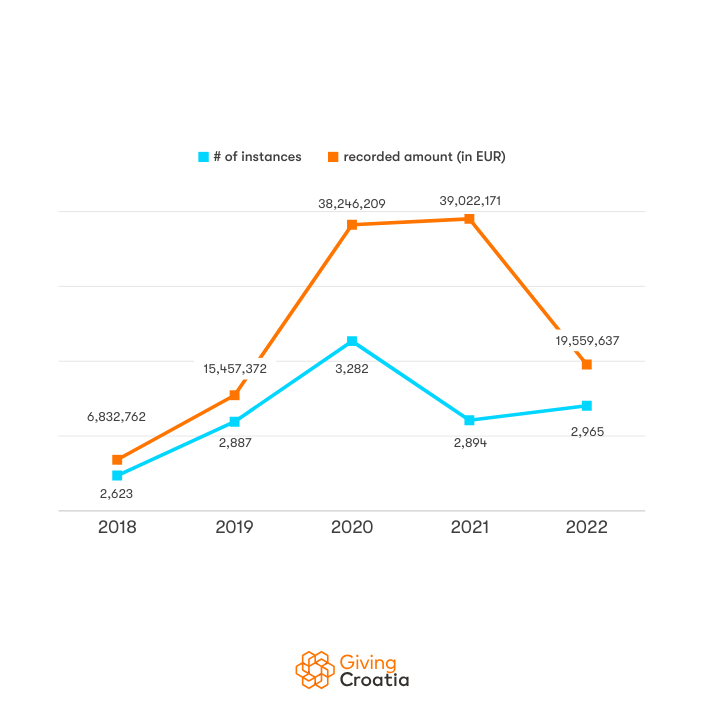Giving Croatia 2022
Giving Croatia 2022: Report on the State of Philanthropy
Divider text here
This report represents detailed insight into charitable giving in Croatia in 2002, presenting the trends of giving, who were the donors, what were the recipients and main causes of giving, and other key indicators of philanthropy.
Since 2013, Catalyst Balkans has been monitoring philanthropic activity in Croatia and other Western Balkans region countries, and providing annual reports on the state of philanthropy which show a unique view of how donors support the social good.
Before presenting the main findings of the report, it is important to have in mind the global philanthropy trends. 2022, the third year of the COVID-19 pandemic, held unique significance due to the ongoing global crisis. Simultaneously, the Ukrainian war outbreak highlighted the need for urgent action. The aftermath of COVID-19 continued to impact donor communities worldwide, constraining their capacities as economic instability persisted, as highlighted by the Global Philanthropy Indices and the Charity Landscape 2022 report. Giving in the Western Balkans, as well as worldwide, is in decline.
TOTAL RECORDED GIVING
19,560,000 EUR
Recorded amount
2,965
# of instances
![]()
5.1 EUR
Donated per capita
The total recorded amount of donations in Croatia in 2022 generated more than EUR 19.5 million through 2,965 unique donation instances. Although this recorded amount was almost 50% less than in 2021, the frequency of giving slightly increased. This decline in the value of donations can be attributed to reduced crisis-related donations, the earthquake in particular, which had a major impact on the donated amount previously in 2020 and 2021. This year, the philanthropic actions were most often intended for the support to marginalized groups and healthcare, with nonprofit organizations being primary recipients.
Data show that in 2022 the total donated amount is lower, which was probably due to different factors; firstly, as the emergency crises passed, there was a lower need for emergency-related giving, and secondly, much like in other countries and the rest of the world economic instability in Croatia had influenced donor capacities. The inflation reached 10.7%. Still, it is important to note that the recorded amount in 2022 is higher than in pre-pandemic years.
TRENDS OF GIVING
The trend of philanthropic giving in Croatia has been fluctuating over the years. Since 2019 the total recorded donated amount has been on the rise, with notable spikes in 2020 and 2021 due to the increased need for aid in humanitarian crises, such as the earthquakes in Zagreb and Petrinja, Sisak and Glina, and the COVID-19 pandemic. In 2022, a decrease of around 50% in the donated amount was recorded when compared to 2021. However, in terms of the frequency of donations, the number of instances slightly rose, reaching the highest number since 2013, excluding the pandemic year. The donated amount per capita was EUR 5.1.
RECIPIENTS
Nonprofit organizations continued to be the predominant recipients of donations in 2022, with an even higher share of all donation instances and recorded value than in the year before. This increase was mainly recorded for the support to marginalized groups and healthcare, and in giving through events.
Conversely, there was a notable drop of more than 10% in direct giving to individuals and families. We can attribute this decline to the fact that the heightened giving to individuals and families in 2021 was a response to the increased demand for support to people affected by the earthquake.
CAUSES
In 2022, there was a shift in the primary causes of giving. After two years marked by crisis-related giving, support for marginalized groups emerged as the predominant cause in 2022, with a rise in the share of donation instances, from 18.1% in 2021 to 25.9% in 2022. In the period before 2020, this theme was most frequently supported, so somewhat decline in giving for emergency management made space for donors to again look into the support that is needed for the wide range of beneficiary groups. The frequency of giving also slightly increased for healthcare and poverty relief.
As for the recorded values, the biggest share was directed toward healthcare.
DONORS
FINAL BENEFICIARIES
For the past two years, the population of local communities represented the most frequent beneficiary type. Giving during crises was directed to people from earthquake-affected areas as well as to different communities all over the country during the COVID-19 pandemic.
Now in 2022, the frequency of support to this beneficiary group subsided, while the number of instances for other key beneficiaries increased: people with health issues, people with disabilities, and people in economic need. Monetary-wise, the biggest share of the recorded amount was directed at the population from local communities, mainly for education, culture and arts, and healthcare.
INTENDED EFFECTS OF GIVING
Looking at the data for the intended effect of giving we can conclude that since 2018, the trend of predominant short-term giving has been present in Croatia. In 2022, short-term giving has seen an increase, both in terms of frequency and the recorded amount. Mainly this increase correlated with the rise of giving for the support of marginalized groups – through giving of supplies and consumables, and seasonal giving.
As for the strategic intended effect of giving, while donations of equipment still played a significant role in long-term giving, their prevalence was not as large as in 2020 and 2021.
GEOGRAPHIC DISTRIBUTION OF GIVING
In the last three years, the majority of donation instances were distributed to the Northwest Croatia region. However, in 2022, a notable shift in this trend occurred, with the Adriatic Croatia region becoming the most frequently supported. Both Northwest Croatia and Adriatic Croatia experienced an increase in donation instances compared to the previous year, while there was a decrease in the frequency of support directed to the Middle and Eastern Croatia region.
See the infographic for more data about giving in Croatia in 2022.
Learn more about our methodology here.


